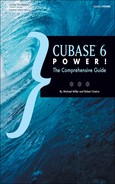0%
51Chapters
0-1Hours read
0kTotal Words
Book Description
Take your Cubase 6 project from idea to finished product using tips and guidance in CUBASE 6 POWER! Packed with useful tips and detailed explanations, this book is your guide to taking advantage of all that Cubase 6 has to offer to make a powerful difference in your music output. Whether you're a recording professional, hobbyist--or even a beginner to the field--authors Michael Miller and Robert Guerin offer the clear and concise information you need to successfully navigate each step of the recording, editing, and mixing process with Cubase.
Table of Contents
- Copyright
- Acknowledgments
- About the Authors
- Introduction
- I. Setup
- 1. Introducing Cubase
- 2. Understanding Cubase Recording Technology
- 3. Setting Up Peripherals
- 4. Monitoring and Connecting Audio
- 5. Creating a New Project
- II. Recording
- III. Navigation
- IV. Editing
- 19. Using the Sample Editor
- 20. Using Audio Processing Options
- 21. Editing Vocals
- 22. Editing MIDI Events with the In-Place Editor
- 23. Using the Key Editor and Note Expression
- 24. Editing MIDI Drum Tracks
- 25. Understanding MIDI Menu Options
- 26. Quantizing Events
- 27. Adding MIDI Track Effects
- V. Arranging
- 28. Arranging in the Project Window
- 29. Using the Arranger Track
- 30. Working with Tempo
- 31. Working with Beats and Loops
- VI. Mixing and Mastering
- 32. Using the Mixer
- 33. Working with FX Channel Tracks
- 34. Adding Equalization
- 35. Working with Group Channel Tracks
- 36. Writing and Reading Automation
- 37. Mixing for Surround Sound
- 38. Mastering and Exporting the Final Mix
- VII. Managing
